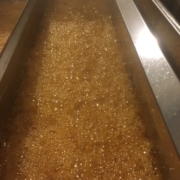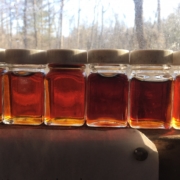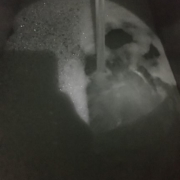Dispatch from the Sugarwoods, 3/17/20
The weather cooperated yesterday – the hard freeze in the morning felt like the sort of freeze you’d get in mid-February. The sap didn’t start running until around noon, which let us catch up a little. We acid washed the pans to remove the scale on the bottom. We canned and moved syrup which had backed up in the finishing pan.
We’re in this weird place, mentally, because the calendar and the cool weather says we should be in the thick of things, but our guts, and much of what we’re seeing outside, say the end is near. Last year we were just getting going in mid-March. But this winter and early spring have been very different. The snow’s gone here. The red maple and popple buds are bordering on breaking. There were reports last week of wood frogs in town. The syrup we’re making is still on flavor, but it’s very dark. The high temperatures forecast for Friday are in the 60s. It feels like early April.
There are always swings in where the season ends from year to year. Last year we ended on 4/7. The year before that on 4/4. The year before that on 4/2. The year before that on 3/26. The year before that on 4/14. The only time in our records that we’ve ever ended in mid-March was 2012, which was a truly bizarre year when late March felt like May.
And so we hold out hope. And we’ll wait and see.
Dispatch from the Sugarwoods – 3/13/20
It’s 4 a.m. on the 13th of March. A hard rain on the roof. The house is quiet otherwise, save for the woodstove – it ticks comfortingly as it heats up and the metal expands. I’m drinking coffee and building momentum to get out there again. A small radio in the kitchen had been broadcasting news about the COVID-19 microbe that’s terrorizing the world, but I shut it off to hear the rain and the woodstove ping.
The 1,600-gallon sap tank at the bottom of the hill will be close to overflowing; the 2,500-gallon tank across town probably already has. And it’s warm – too warm. The sap will soon begin to spoil. It looks clear when the weather is cold and the season is fresh. Then it goes to a sort of bluish-gray as ambient temperatures rise. When temperatures get above 60, the sap begins to look like watered-down milk. In the bottom of the tank there are handfuls of white precipitate – I suppose that gunk is yeast.
There’s so much to tell you about this season, and I will. But for now I’ll leave you with the idea that time is of the essence, and the image of milky sap. Microbial colonizers – harmless to humans but brutal to syrup quality – have inundated our sap collection system and their populations are exploding. In cool sap, microbial concentrations are less than 1,000/ml. In this weather, concentrations can be in the billions, or even trillions, per milliliter.
They feast.



